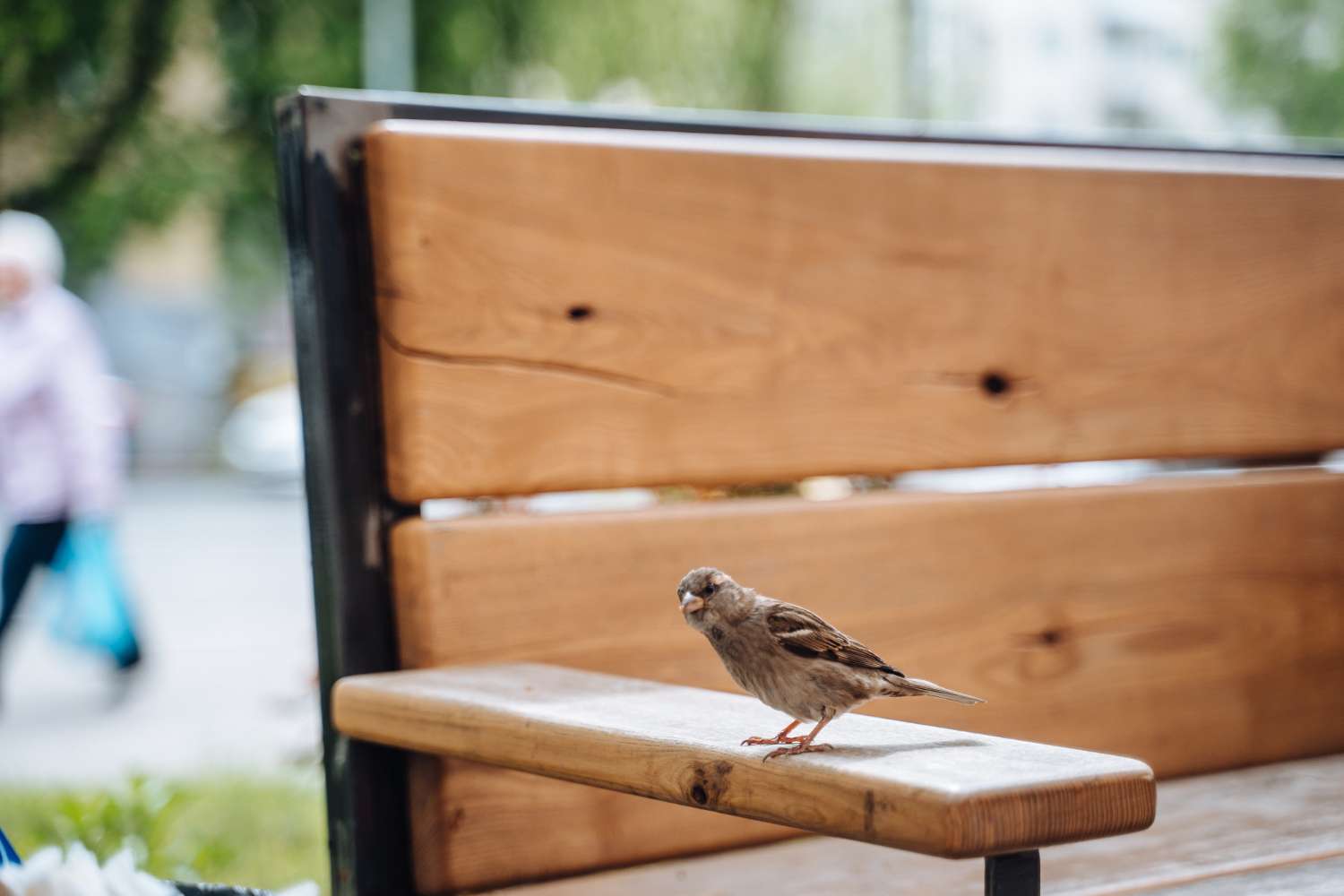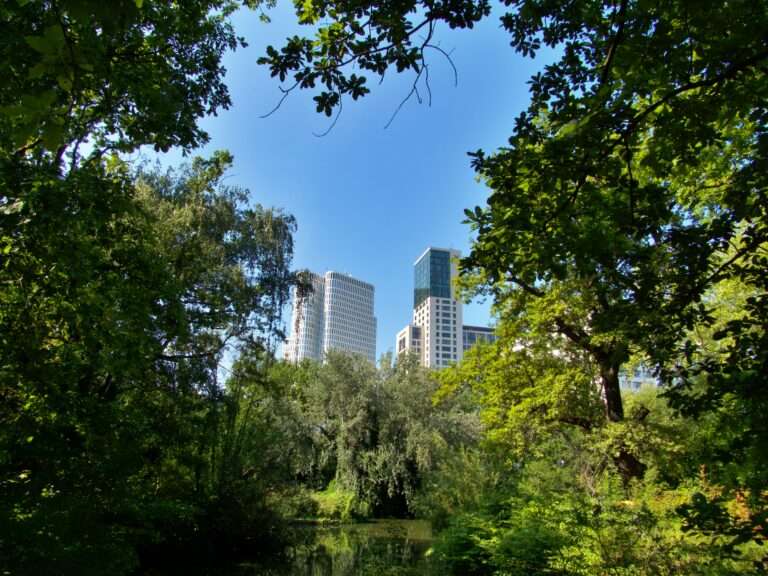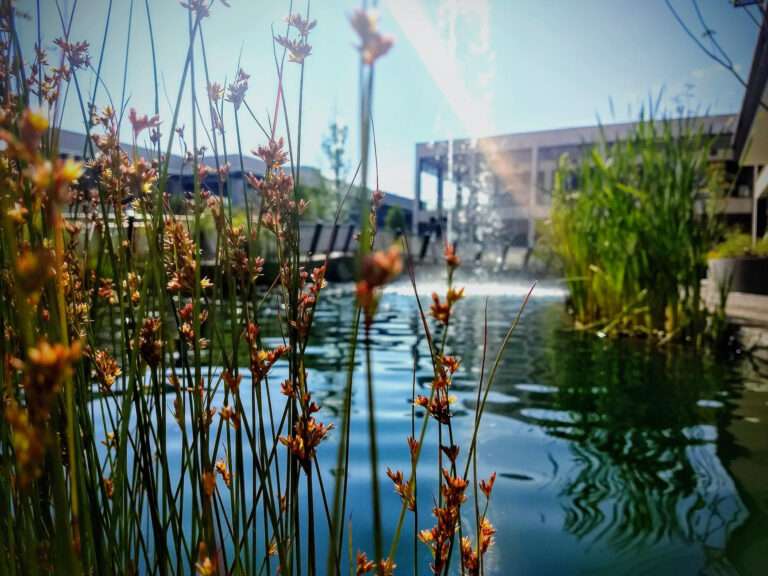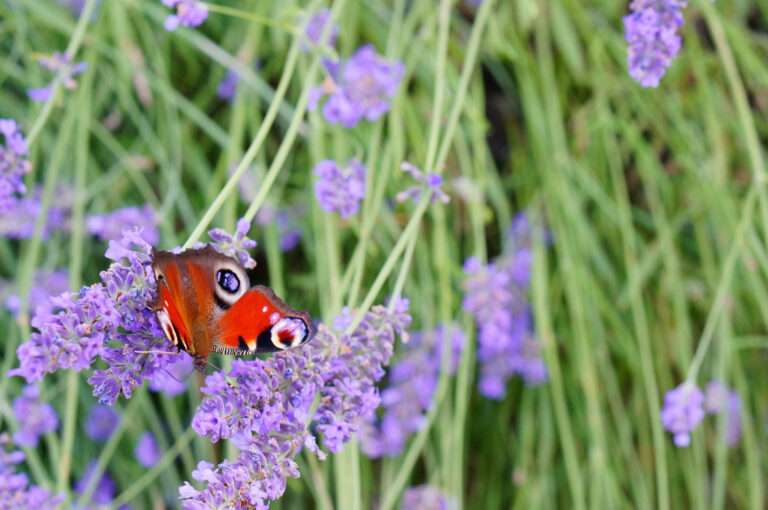Why Bird and Bat Boxes Belong in Every Built Environment
Cities aren’t as dead to nature as we sometimes think. Look closely – that tree-lined avenue, that quiet courtyard between office blocks, that forgotten railway embankment – and you’ll see flashes of movement, wings, and small life quietly adapting. But let’s be honest: our built environments don’t make it easy for wildlife to find a home.
That’s where bird and bat boxes come in. They might look like simple wooden structures, but they’re lifelines – tiny, engineered refuges that tip the balance for species struggling to survive amid bricks and concrete. In an age of biodiversity decline, it’s these small interventions that can make the biggest difference.
And yet, most developments still treat them as an afterthought. A tick-box exercise to satisfy planning requirements. That’s a mistake. Because when done properly, habitat creation can be more than a compliance task – it can bring genuine ecological and social value to a project.
So, let’s talk about why bird and bat boxes matter – and why they’re becoming a defining feature of forward-thinking developments across the UK.
What Do We Mean by ‘Built Environment’?
We tend to think of cities and towns as human territory. But the built environment isn’t a single, homogenous block of concrete – it’s a patchwork of roofs, walls, courtyards, gardens, and verges. Some of it’s hard and sterile. Some of it, surprisingly, teeming with life.
The term itself covers everything from new housing estates to business parks, public buildings, schools, and industrial sites. Each of these has the potential to host micro-habitats – spaces where wildlife can nest, rest, or hunt for food.
But here’s the problem: modern construction methods seal off those opportunities. Tight roofing membranes, smooth cladding, plastic soffits – great for energy efficiency, terrible for wildlife. The crevices that once supported generations of swifts or pipistrelle bats are disappearing.
And once those nesting sites go, they rarely come back. Unless we put them there deliberately.
The Case for Bird and Bat Boxes
Installing boxes isn’t just about being “nice to nature.” It’s about restoring balance. Bats and birds are natural pest controllers, pollinators, and pollination spreaders. Their presence helps ecosystems function – even in urban areas.
Think about it: a single pipistrelle bat can eat over 3,000 insects a night. Blue tits can clear thousands of caterpillars from trees each breeding season. Swifts feed on midges and mosquitoes. These are free ecosystem services, delivered nightly, with zero carbon footprint.
When we strip habitats bare, we remove those benefits. Boxes, by contrast, offer an easy way to reinstate them.
They also have measurable results. The Bat Conservation Trust reports that urban bat populations are showing signs of recovery in areas with sustained habitat provision. Similarly, RSPB studies show that simple nesting boxes can double local breeding success for small birds when installed correctly.
And yes, it’s not all scientific. There’s something quietly uplifting about seeing swifts sweep across a development at dusk or hearing a blackbird’s call echo through a courtyard. It softens hard edges. Makes a place feel lived in – properly lived in.
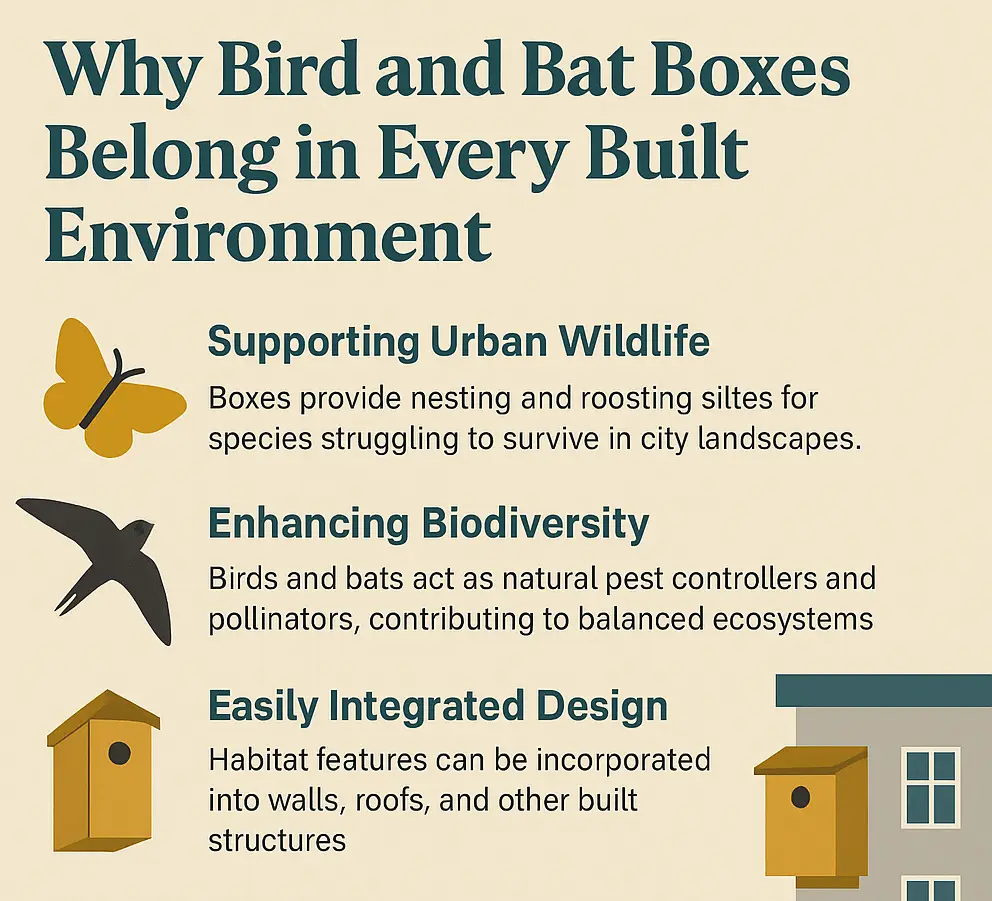
Integrating Habitats into Modern Design
One of the biggest shifts in ecological design over the past decade has been moving from add-ons to integration. Instead of bolting a box onto a wall as an afterthought, designers are building habitats into the architecture itself.
You’ll see swift bricks – hollow units built directly into walls. Bat tubes embedded beneath tiles. Green roofs that retain moisture and support insects. It’s the kind of design thinking that treats biodiversity as a material, not an ornament.
There’s a practical side too. Built-in boxes last longer, need less maintenance, and don’t interfere with building aesthetics. Some developers even go a step further, combining them with living walls or sculptural features that celebrate their presence.
Still, a word of caution. Throwing up boxes at random isn’t enough. Placement, height, direction, shade, and proximity to feeding areas all matter. A bat box on a north-facing wall is useless. A bird box beside a busy vent? Forget it.
That’s why ecological planning at the design stage is essential. For developers and contractors, this often falls under biodiversity enhancement measures – something covered in detail on our page about bird and bat box installation.
Species Spotlight
| Species | Typical Box Type | Preferred Placement | Active Months |
|---|---|---|---|
| Swift | Swift brick | High, shaded wall (5m+) | May – August |
| Pipistrelle bat | Bat box/tube | South or west-facing wall, 3–5m high | April – October |
| Blue tit | Small hole box (25mm) | Sheltered wall or tree, 2–4m | February – July |
| House sparrow | Terrace box | Eaves or sheltered ledge | February – August |
| Starling | Larger hole box (45mm) | Gable or fascia, 3m+ | February – July |
These are broad guidelines, not hard rules. Local conditions matter. For instance, in coastal towns, swifts might arrive earlier; in upland regions, bats may hibernate longer. The trick is to observe and adapt – nature rarely reads the manual.
Why It Matters for Urban Biodiversity
The UK’s biodiversity has been in decline for decades. Nearly half of our bird species are now of conservation concern. Urban areas, covering more than 10% of the UK’s land surface, could – and should – play a vital role in reversing that.
The built environment can’t replace ancient woodland or wetlands, but it can act as a network of stepping stones – little safe havens connecting larger habitats. Bats, for instance, navigate by following linear features like hedgerows or canals. Adding roosting boxes along these corridors helps maintain population movement and genetic diversity.
It’s easy to dismiss such measures as “too small to matter.” But think of it cumulatively. A hundred developments, each with a dozen boxes – that’s over a thousand potential homes for species otherwise displaced.
And it’s not only the animals that benefit. Studies by Natural England and the University of Derby show that residents in greener developments report higher satisfaction and lower stress levels. So in a roundabout way, bird and bat boxes are good for human wellbeing too.
The Planning and Policy Angle
If you’ve been involved in development projects lately, you’ll know biodiversity is no longer optional. The Biodiversity Net Gain (BNG) legislation requires most new developments in England to deliver at least a 10% measurable increase in biodiversity compared to the pre-development baseline.
That can mean tree planting, wildflower seeding, or habitat creation. But often, one of the simplest ways to contribute is through nesting and roosting provision.
Many local authorities have specific guidance too. Some, like Brighton and Hove, now require integrated swift bricks in all new residential developments. Others, such as Nottingham or Bristol, recommend a minimum number of boxes per dwelling or per hectare.
It’s worth noting that compliance alone doesn’t guarantee success. The quality of installation and long-term management plan matter just as much as the number of boxes. Without proper monitoring, a “biodiversity feature” can quickly become decorative clutter.
Practicalities – Getting It Right
Let’s get real. Not every bat box becomes a roost. Not every bird box attracts a nesting pair. There’s a bit of trial and error involved.
But there are some non-negotiables:
- Correct orientation – south or southeast for warmth, with shade for bats.
- Secure mounting – boxes should be fixed solidly, with no movement in high winds.
- No disturbance – once occupied, boxes should not be opened or cleaned without a licence (especially bat boxes).
- Maintenance access – ensure boxes can be checked safely as part of ecological monitoring.
In my experience, the most successful installations come from collaboration. Ecologists, architects, site managers – all working together early in the design process. It sounds idealistic, but when you get it right, the results are genuinely satisfying.
And it doesn’t have to be expensive. A standard timber bird box costs less than a cup of coffee. A built-in swift brick, maybe £25–£40. Even the higher-spec concrete boxes pay for themselves in longevity.
Beyond Compliance – Cultural Value
There’s a cultural side to all this too. Birds and bats are part of our collective memory. Swallows nesting in barns. Bats flickering through churchyards at dusk. Lose those moments, and we lose something intangible but deeply rooted.
Developments that reintroduce those experiences – even in subtle ways – make places feel human. They remind us we share space with other species.
I’ve walked through new housing estates that feel sterile and lifeless. Everything paved, trimmed, uniform. Then there are places where you catch the sound of swifts overhead, or a robin’s song bouncing off brickwork. The difference is night and day.
Creating habitats in the built environment isn’t about nostalgia. It’s about reconnection.
Challenges and Misconceptions
Some developers worry about bats halting construction or nesting birds delaying work. Fair point – those are real risks if mitigation isn’t planned properly. But installing boxes early, in consultation with ecologists, usually prevents such issues.
Another misconception is that boxes attract pests or create mess. In truth, well-placed boxes cause minimal disruption. They’re discreet, silent most of the year, and generally out of reach.
Then there’s the “what’s the point?” argument – that one or two boxes can’t fix systemic habitat loss. That’s true, in isolation. But scale it up, integrate it across estates, business parks, and schools, and suddenly you’ve built a living network.
We can’t all restore forests. But we can all screw a box to a wall.
Conclusion
Creating habitats in the built environment is no longer a token gesture. It’s an essential part of sustainable development – a way of designing places that acknowledge, not exclude, the natural world.
Bird and bat boxes aren’t silver bullets. But they’re visible, tangible steps in the right direction. They turn empty walls into living structures, give displaced species a second chance, and remind us that even in the densest city, nature still finds a foothold.
If every new build, every warehouse, every public park made room for just a few – the combined effect would be transformative. Quietly, invisibly, the sky above our towns might once again fill with wings.
Killingley Insights is the editorial voice of NT Killingley Ltd, drawing on decades of experience in landscaping, environmental enhancements, and civil engineering projects across the UK.


